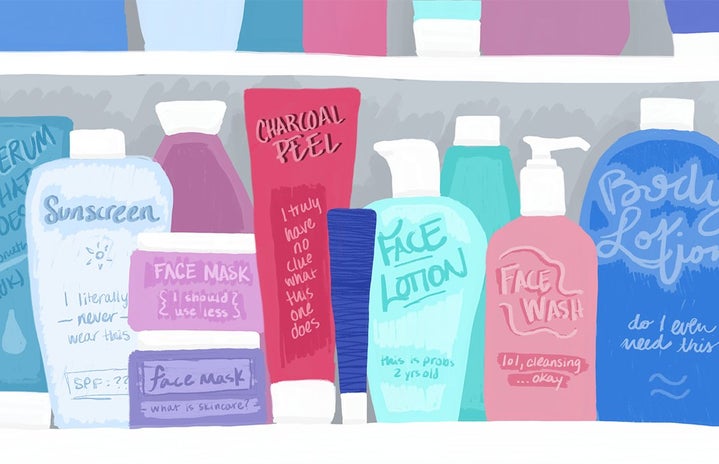Whether walking into a drug store or to a local Target, a new skincare brand or product is always being advertised right from the entrance. With an endless number of products on the shelves, scanning the aisles alone can be a daunting task for those who do not know much about skincare ingredients. Rather than advertise products, the purpose of this article is to provide education on skincare ingredients to allow consumers to make their own decisions, fit to their specific needs. When considering what products to use, following a simple routine containing sunscreen, cleanser, moisturizer and an exfoliant in certain cases works the same or better at removing impurities and preventing skin damage than the advertised 12-step routines do. In addition to using products, step back from the aisle and take a holistic approach to healthy skin by assessing lifestyle choices such as diet and exercise which both play a significant role in maintaining skin’s integrity.
Sunscreen
Sunscreen is the only step of a skincare routine that should absolutely not be skipped. Every single day, including cloudy days and winter, sunscreen with SPF 30 minimum should be applied to all exposed skin, but especially to the face. Dermatologists recommend reapplying every two hours, but take a realistic approach. The sun causes early aging, wrinkles, dark spots, sunburn, and even cancer, so any amount of sunscreen protects the skin far better than going without it.
Sunscreen comes in two variants, physical and chemical. Physical sunscreen sits on top of the skin and reflects the sun’s rays, specifically UVA rays, which cause early aging, and UVB rays, which can cause cancer and sunburn. The active ingredients are zinc oxide and titanium dioxide, which do not absorb into the skin. Physical sunscreen’s benefits include safety, effective UV protection, minimal irritation and extra moisture. Its drawbacks include a heavy formulation, difficulty blending into the skin and likelihood of leaving a white cast on the skin.
Chemical sunscreens absorb into the skin, absorbing UV rays and expelling them as heat. Consumers may be drawn to chemical sunscreens due to its lighter formulation and easier blending ability, however, it has notable negatives. Common active ingredients including but not limited to avobenzone, octinoxate and oxybenzone have been labeled by the FDA as endocrine disruptors. Endocrine disruptors interfere with the body’s natural hormone production and are linked to numerous health issues. Because chemical sunscreens are absorbed into the skin, these chemicals can be found in the bloodstream after a single use. A final downside is that physical sunscreens simply protect against the sun’s rays better, providing a thicker, more effective barrier.
Physical sunscreen bests chemical sunscreen in UV protection, safety, and is even safer for the planet’s waters. As a final note, when choosing any skincare product, look for these phrases on the bottle: non-comedogenic (not pore-clogging), fragrance-free, and dye-free. Consistent sunscreen use is the best way to protect the skin. Your future self will appreciate it!
Cleanser
Throughout the day, sebum, dirt, bacteria, pollution, and makeup build up on the skin and can cause breakouts and clogged pores if not properly removed. Choosing the right cleanser can clear buildup, improve skin texture and allow moisturizer to penetrate the skin better. Cleansers are generally made up of surfactants, which clean the skin, added moisturizers, and preservatives that keep the product fresh and free of bacteria.
For surfactants, look for nonionic surfactants such as polysorbate or propylene glycol, or silicone-based surfactants such as dimethicone. Both are non-irritating and cleansing, but silicone has the added benefit of moisturizing. Avoid sulfates such as sodium lauryl sulfate as they are irritating and drying on the skin. In general, the moisturizers present in cleansers are safe, so they will not be covered here.
Preservatives present the most skincare and general health concerns. Watch for any form of parabens, which may be carcinogenic, or cancer-causing, when applied to the skin. Formaldehyde, another known carcinogen, allergen and skin-irritant, commonly finds its way into skincare, but under different names. Formaldehyde donors, for example diazolidinyl urea, quaternium-15 or DMDM hydantoin, release small amounts of formaldehyde over time to keep the cleanser fresh. Proceed with caution and research the preservatives that end up on the skin each day. Additionally, avoid fragrances, dyes and phthalates, which may also be carcinogenic.
The right cleanser should not leave the skin feeling tight or restricted. To determine skin type, wash the skin and apply no product. After 30 minutes, if the skin feels tight, it is dry. If it feels normal, it is normal. If it feels a bit greasy, it is oily. If the cheeks are dry and the t-zone is oily, then it is combination. Finally, if the skin reacts poorly to skincare products or other environmental changes, it is sensitive.
Cream and milk cleansers work best for dry or sensitive skin. The thicker formulations are designed to gently cleanse skin and replenish moisture simultaneously. Oil cleansers generally work better for sensitive, dry and normal skin, but if combined with surfactants can be used on combination and oily skin as well. Oil cleansing may seem prone to clogging pores, however oils are solvents, meaning they dissolve the oil on the skin leaving it clean and moisturized. Gel cleansers and foaming cleansers are great for normal, combination, and oily skin. Gel cleansers feel thicker and more deeply cleansing, while foaming cleansers feel lightweight and refreshing on the skin.
Moisturizer
All skin types, including oily skin, need moisturizer. While it may be obvious to moisturize dry and sensitive skin types, normal skin can become dry if it is stripped by cleansers without moisture replenishment. In contrast, combination and oily skin types may become overly oily in response to a lack of moisture replenishment. Moisturizer ingredients are generally safe and mild for all skin types, but they may contain similar preservatives to the ones previously mentioned. However, the current focus will be on choosing the right formulation for each skin type.
From least to most moisturizing, the four types of moisturizers are gel, lotion, cream and ointment. Gel moisturizers feel lightweight on the skin and are best suited to oily skin and the oily portion of combination skin. Because they are water based, they absorb quickly into the skin, avoiding a greasy feeling on the skin. Suitable for most skin types, lotions take a slight step up from gels in moisture content, but may be too heavy for oily skin. Creams come in a thicker, white-colored formulation that works best for dry and sensitive skin due to their heavier moisturizing properties. Lastly, ointments are the thickest, most hydrating moisturizer, typically used for medical purposes to treat certain symptoms.
While many ingredients such as vitamin C and peptides are marketed to have incredible results, few of these ingredients actually have the research to back up their claims. These ingredients may have anecdotal benefits and do not harm the skin, but they have not been thoroughly studied in skincare. A few moisturizing ingredients with substantial research into their benefits are hyaluronic acid, ceramides, and niacinamide. Hyaluronic acid binds water in the skin, leaving it looking more firm and plump while also promoting regeneration. Ceramides block moisture from leaving the skin, keeping it moisturized. Niacinamide helps similarly to ceramides, but additionally has some evidence suggesting its ability to repair the outer skin barrier.
Exfoliant
Exfoliants are completely optional, but have many uses including removing dead skin cells, unclogging pores, improving acne, smoothing wrinkles and helping other products absorb into the skin better. However, physical exfoliants, the type containing little plastic beads, should never be used. In addition to being far too abrasive for all skin types, they are also terrible for the environment. Chemical exfoliants provide a gentler alternative, but should still be thoroughly researched and used with caution. For sensitive skin especially, speak with a dermatologist before using any of the following chemical exfoliants.
AHA, or alpha hydroxy acid, is a powerful exfoliant due to its ability to penetrate the skin and encourage dead skin cells to shed from within. The inner layer of skin thickens while the outer layer thins and smoothes. Generally, AHA is recommended towards oily or combination skin which may need a more powerful exfoliant than other skin types.
BHA, or salicylic acid, is milder than AHA and more suitable for all skin types, with the exception of sensitive skin. It is not able to penetrate into the skin and removes dead skin cells by dissolving them layer by layer. Its results are more subtle, but it has the added benefit of being less irritating to the skin.
Retinol, a form of vitamin A, not only exfoliates the skin and unclogs pores, but also promotes skin cell production, thickening and smoothing out the skin. However, retinol is the most harsh of all these ingredients, and should be used with caution. It often causes a “purge” in the skin, where the skin becomes worse before it begins to improve. Most importantly, retinol causes sensitivity to the sun, so it should only be applied at night followed by a regular sunscreen regimen in the daytime.
Exfoliants often seem to be marketed as miracle products and they may really provide beneficial results when used carefully and in moderation. Using these products too often quickly leads to irritation, sunburn, and other negative effects. Additionally, over-exfoliation of dry skin may seem like the answer to removing excess dead skin cells, but it causes more harm than good. Like all aspects of skincare, slow and steady wins the race, so watch out for “quick fixes.”
Holistic approach
Aside from following a skincare regimen based on skin type, it is also essential to consider your daily lifestyle, as there is a direct relationship between overall well-being and skin appearance. Taking in this holistic perspective and associated environmental factors not only prevents inflammation but also acne and aging. Following a balanced diet will promote gut health, which reduces inflammation, and ensures your skin is receiving the nutrients it needs to be healthy. In addition, incorporating moderate exercise into your daily schedule allows the skin to improve elasticity and remove impurities with heightened oxygen flow and, of course, with follow-up skin care after your sweat session. Lastly, and most importantly, drink plenty of water throughout the day to keep the skin hydrated and remove toxins via increased circulation, paired with the right moisturizer. The skin reflects overall health, so it is imperative to acknowledge physical health and make adjustments for the betterment of skin health. Remember, skincare is a part of self-care and should be prioritized not only to protect current skin but also to promote future healthy skin growth.
This guide can hopefully encourage some individual research into the compounds used on the skin daily and promote conscientiousness when considering the marketing of unnecessary skincare products. Happy googling!



